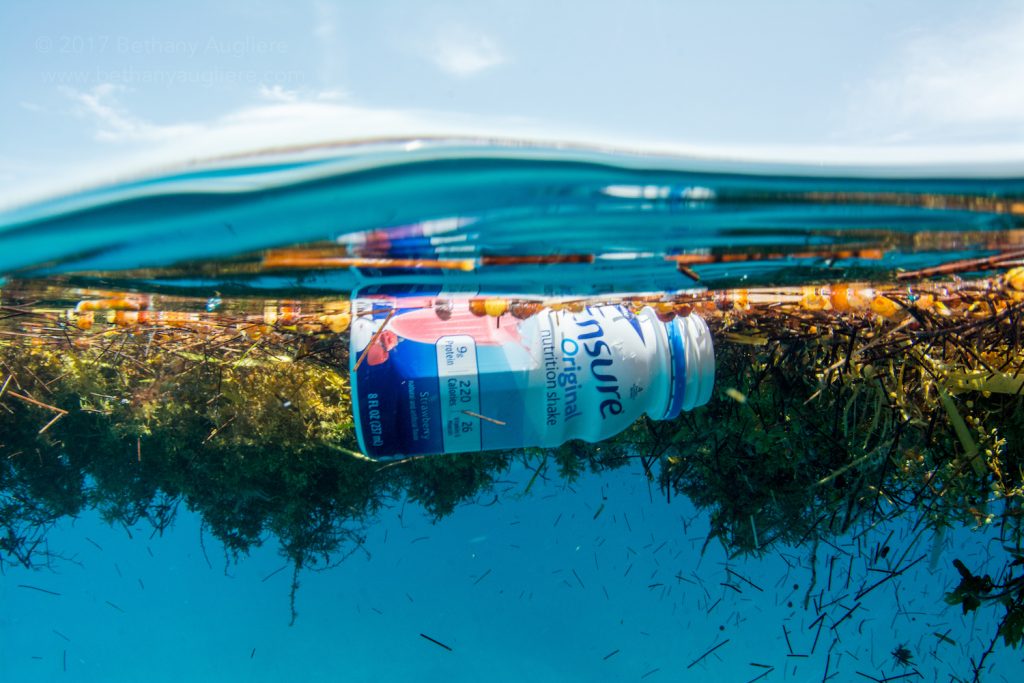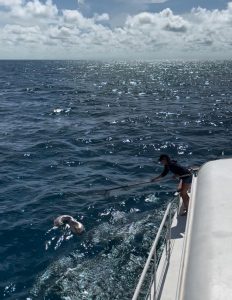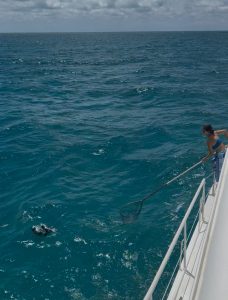
Plastic floating in a seaweed patch in the Bahamas, in dolphin habitat. Photo by Bethany Augliere/Wild Dolphin Project.
During our 2025 Bahamas field season with the Wild Dolphin Project, our team collected 21 balloons floating at or near the ocean’s surface — and that was from just one trip. Over the course of the summer, we encountered and removed many balloons and other forms of marine debris, including two large beanbags drifting in dolphin habitat.
At first, it may not sound significant. However, this small sample illustrates a larger and persistent issue — the widespread presence of plastic debris in marine ecosystems. Balloons, along with other forms of plastic waste, represent one of the most preventable sources of pollution impacting ocean wildlife today. Approximately 11 million tons of plastic enters the ocean every year. That’s the equivalent of us dumping 2,000 garbage trucks full of plastic into the world’s oceans, rivers, and lakes every single day, according to UNEP. And 3% of Atlantic deep-sea debris items seen by the Okeanos Explorer from 2013-to 2019 consisted of balloons, according to NOAA.

Balloons in the Ocean: What Happens After Release
When a balloon is released into the air, it doesn’t simply disappear. Most eventually burst and fall back to Earth, often into waterways that lead to the ocean. Balloons are made of materials like latex or mylar, which degrade very slowly in marine environments. As they break apart, they contribute to the growing problem of microplastic contamination.
Marine animals, including dolphins, turtles, and seabirds, can mistake these items for food or become entangled in the attached ribbons. Ingestion of plastic materials can block digestive tracts, cause internal injuries, and lead to malnutrition or death. Entanglement can restrict movement, interfere with feeding, and in severe cases, cause drowning.
Why This Matters for Dolphins
The Wild Dolphin Project has studied the same population of Atlantic spotted dolphins in the Bahamas since 1985. These dolphins rely on a clean and balanced marine ecosystem to survive. Increasing levels of plastic pollution threaten that balance. And while debris collection isn’t part of our formal research goals, but it has become an unavoidable part of fieldwork. Each item we remove is a reminder that human activity on land continues to reach the middle of the ocean. By documenting and sharing what we find, we hope to raise awareness of how everyday choices — such as releasing balloons or using single-use plastics — can have far-reaching consequences for marine wildlife.
So, the takeaway is simple: every balloon released has a high probability of ending up in the ocean. From there, it becomes another risk factor for marine life.
There are many simple and creative alternatives to balloon releases — such as bubbles, flags, flowers, handmade decorations from shells collected on the beach, or painted cardboard from recycled boxes. Reducing single-use plastics and supporting local cleanup and research programs can also make a real difference.
So, the next time you’re planning a celebration — whether it’s a baby shower, birthday party, or memorial — take a moment to consider the potential impact that balloons can have on the environment and marine life. There’s almost always another way to celebrate and decorate that’s just as meaningful, and far kinder to the planet.

Want to follow more of our research, trips and see our team collecting balloons, be sure to follow us on Instagram, Facebook and Bluesky.
